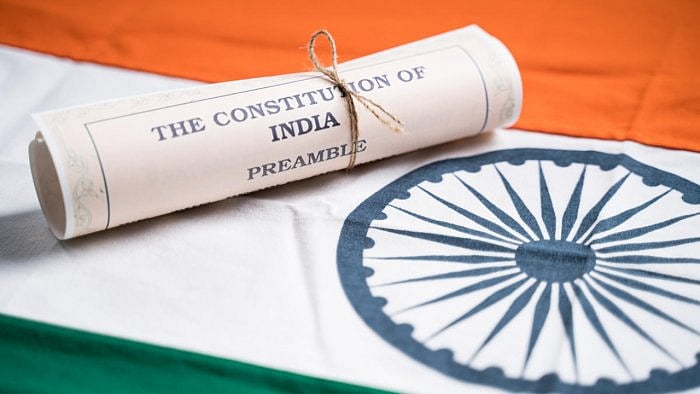
Constitution of India. (Image for representation)
Credit: iStock Photo
In 1952, in the Sir Alladi Krishnaswami Aiyer Endowment lectures at the University of Madras, Sir Ivor Jennings argued that the Indian Constitution was “far too large and therefore far too rigid”. He pointed out that it sought to “establish democratic institutions, not to express democratic ideas as legal principles.” More than seven decades later, that distinction still shapes India’s democratic experience.
Though often described as flexible — a view supported by Ginsburg, Elkins and Melton’s 2007 study, which found that written constitutions survive an average of just 17 years — India’s institutional performance tells a more complicated story. A closer look at the legislature, executive and judiciary reveals how the gap between constitutional design and everyday democratic practice has widened.
Shrinking space for debate in lawmaking: The decline in parliamentary sittings is now a familiar headline. In the 1950s and 60s, Parliament met for 125–130 days a year. Today, the figure hovers between 60 and 75, with 2024 marking a new low at under 50 days. This prompted MPs Manoj Kumar Jha (2022) and Derek O’Brien (2025) to introduce bills mandating minimum sittings of 120 and 100 days. Their argument was simple: a shrinking calendar means poorer scrutiny, weaker debate and hurried legislation — all of which undermine Parliament’s role as a forum of accountability.
The monsoon session, held from July 21 to August 21 this year, underlined the trend. Productivity was only 31% in the Lok Sabha and 39% in the Rajya Sabha. Of the allotted 120 hours, barely a third was used for discussion. State legislatures are showing a similar pattern. PRS Legislative Research reports that assemblies met an average of just 20 days in 2024, down from 22 in 2023. The outcome is predictable: legislatures increasingly look like rubber stamps.
The executive: Mostly a paper tiger: The executive — both political and bureaucratic — is tasked with turning laws into results. India’s civil services are among the world’s oldest and most structured, yet their performance at the ground level remains stubbornly uneven. Transparency International ranks India 96 out of 180 in its Corruption Perception Index, while Political and Economic Risk Consultancy ranked India second-worst in Asia for perceived corruption in 2024, just above Vietnam.
India climbed from 142 to 63 in the World Bank’s Ease of Doing Business rankings between 2014 and 2019. But the sub-indicators painted a less flattering picture: India ranked 136th in starting a business and 163rd in enforcing contracts.
Retired bureaucrat N C Saxena has argued that political interference in the IAS expanded in the last three decades, aided by “redundant posts and defunct legislatures”. Many civil servants work with outdated skill sets; domain specialisation remains patchy. The result is an administrative machinery that is hierarchical, risk-averse, and stretched thin, especially in areas such as public health, local governance, and contract enforcement.
The deeper problem, though, is the uneasy relationship between political leaders and civil servants. When transfers are arbitrary and rewards uncertain, bureaucrats become cautious rather than creative. This politicisation blunts accountability and delays service delivery, widening the gap between policy promises and citizen experience.
Judiciary: an eroding counterweight: India’s higher judiciary has long enjoyed a reputation for independence. Through innovations like the basic structure doctrine and the collegium system, the Supreme Court positioned itself as a counter-majoritarian force. Yet this moral authority has dimmed over the last decade, as conflicts with the executive have grown sharper and delays have multiplied.
Much of this tension is tied to centre–state relations. The Supreme Court’s opinion in the 2025 Presidential Reference is a stark example. It struck down the idea of “deemed assent” — introduced by a division bench in the Tamil Nadu Governor case — arguing that fixed timelines for gubernatorial or presidential assent violated the separation of powers, a basic feature of the Constitution.
Legally, the Court’s reasoning may be defensible. But politically, it leaves troubling implications. By upholding open-ended discretion for Governors and the President, the judgment risks enabling partisan obstruction — particularly in opposition-ruled states.
At a moment when judicial pendency is at a historic high and questions of transparency in the collegium persist, the judiciary’s own credibility is under strain.
Citizen’s resurrection
After 75 years, Jennings’ warning rings true in a different way: while India’s Constitution has proved remarkably durable, the institutions it created have not kept pace with its democratic ambitions. Parliament sits less and debates less. The bureaucracy struggles to modernise. The judiciary’s interpretative muscle often fails to translate into democratic deepening.
Meanwhile, identity politics — of caste, class, religion and gender — continues to shape public life, often narrowing the scope for institutional reform. The danger is not the collapse of democracy but its hollowing out: a system where elections are regular but governance is erratic, and where constitutional offices operate without constitutional spirit.
In such an environment, the role of citizens becomes decisive. Public pressure, civic participation and an insistence on constitutional morality may be the only forces capable of nudging the state back toward accountability.
(The writer is an assistant professor at the Symbiosis Law School – Symbiosis International [Deemed University], Pune)
Disclaimer: The views expressed above are the author's own. They do not necessarily reflect the views of DH.